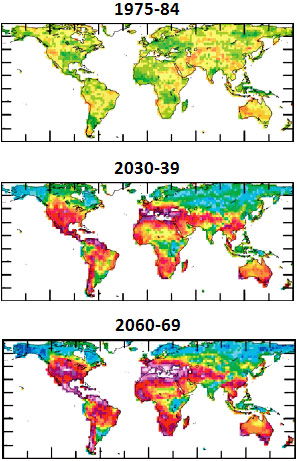Here are a few recent data points for you: (1) The New York Times reports that “skepticism and outright denial of global warming are among the articles of faith of the Tea Party movement.” (2) In the National Journal, Ron Brownstein notes that “The GOP is stampeding toward an absolutist rejection of climate science that appears unmatched among major political parties around the globe, even conservative ones….Of the 20 serious GOP Senate challengers who have taken a position, 19 have declared that the science of climate change is inconclusive or flat-out incorrect.” (3) It’s not just Senate candidates. ThinkProgress notes that an analysis by Wonk Room “finds that 22 of the 37 Republican candidates for governor this November are deniers of the scientific consensus on global warming pollution.” (4) The Wall Street Journal reports that “extreme drought” has taken hold in parts of nine states stretching from the Southeast to the lower Midwest.
As it happens, this southern U.S. drought is probably not caused by global warming — not mostly, anyway. Like most droughts until now, its primary cause is natural climate oscillations (this year’s La Niña) and bad luck (no hurricanes so far this season). But don’t count on that continuing. In a new paper that reviews the recent literature on drought, Aiguo Dai of the National Center for Atmospheric Research in Boulder concludes  that we’re headed for serious and sustained droughts in much of the world. And not in the far future, either. As the maps on the right show, vast swathes of the world are going to be far drier than they are today in a mere 20 years. “A striking feature,” Dai says of his analysis, “is that aridity increases since the late 20th century and becomes severe drought [] by the 2060s over most of Africa, southern Europe and the Middle East, most of Americas [], Australia, and Southeast Asia.”
that we’re headed for serious and sustained droughts in much of the world. And not in the far future, either. As the maps on the right show, vast swathes of the world are going to be far drier than they are today in a mere 20 years. “A striking feature,” Dai says of his analysis, “is that aridity increases since the late 20th century and becomes severe drought [] by the 2060s over most of Africa, southern Europe and the Middle East, most of Americas [], Australia, and Southeast Asia.”
In other words, virtually all of the world except for China and Russia will experience increased drought by 2030 and severe drought by 2060:
This is very alarming because if the drying is anything resembling Figure 11, a very large population will be severely affected in the coming decades over the whole United States, southern Europe, Southeast Asia, Brazil, Chile, Australia, and most of Africa….Given the dire predictions for drought, adaptation measures for future climate changes should consider the possibility of increased aridity and widespread drought in coming decades. Lessons learned from dealing with past severe droughts, such as the Sahel drought during the 1970s and 1980s, may be helpful in designing adaptation strategies for future droughts.
The Sahel drought killed upwards of a million people, and since then the steady increase in drought conditions in sub-Saharan Africa has probably contributed to ongoing crises in Darfur, Chad, and elsewhere. Now imagine what the world will be like when droughts are twice as bad, last twice as long, and cover not just sub-Saharan Africa but upwards of half the landmass of the planet. That’s not really something you can adapt to.
And here’s some even worse news: these projections are based on midpoint global warming projections from the last IPCC report. But those projections are looking increasingly understated, and the next IPCC report is almost certain to raise its temperature forecasts. So as bad as Dai’s drought news is, the reality is probably even worse.
This isn’t something that’s a century in the future. If we don’t do anything about it, it’s more like 20 years away. Tea partiers and their Republican enablers can play make believe all they want, but their kids and grandkids are going to pay the price for it. Global climate catastrophe is looking closer and closer all the time.













